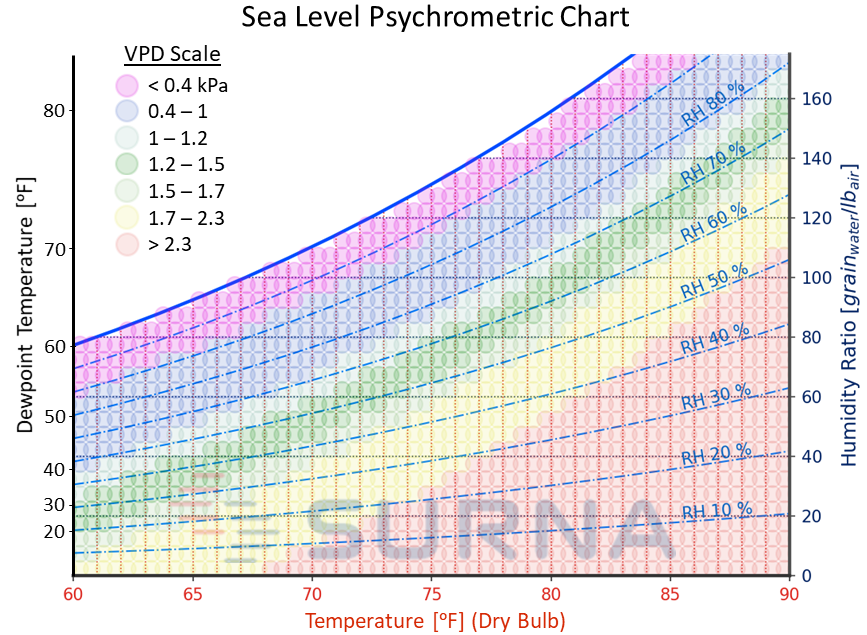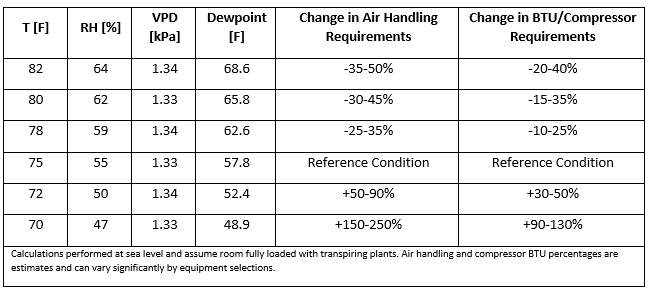Vapor Pressure Deficit (VPD) is defined as the difference between the amount of moisture in the air and how much moisture the air can hold before being saturated. In practical terms, it’s the set of parameters that promotes transpiration of moisture in your plants. VPD is established by the relationship between temperature and humidity in the cultivation space. Obviously, maintaining correct VPD is vitally important to the health and well-being of your crop, as transpiration is the process by which water and nutrients are moved from the root zone up through the plant. Too much transpiration, or too little, have different but equally damaging effects on the plant.
WHAT IS THE “OPTIMAL VPD”?
Unfortunately, there is no single answer. There is peer-reviewed academic research citing optimal values of VPD for tomatoes and other crops. In one model, Shamshiri (2016) report optimal values between 0.6 and 1.1 kPa in sun and 0.4 – 0.7 kPa at night for tomato plants in the vegetative growth stage and 0.6 – 1.4 kPa in sun for tomato plants at the flowering to fruiting stage. For this chart, the “optimal green” is at 1.2-1.5 kPa, similar to other popular VPD charts available online. However, we also understand that temperature and humidity are important as their own parameters to producing certain plant responses independent of VPD. In addition, the risk of microbial proliferation is another factor to consider when deciding on room setpoints.
While VPD is an important parameter, it is certainly not the only one. Surna exists to create environments that balance the many factors in operating a successful cultivation facility.
TEMPERATURE AND HUMIDITY
In HVAC design for cultivation facilities, cooling is an obvious primary function. However, cooling loads are a relatively simple calculation to do. Dehumidification requirements are equally (perhaps more) important and far more complex as it relates to load calculation. When we are identifying dehumidification requirements, we start with the dewpoint temperature the client is looking for—that is, the temperature at which water condenses from gas (vapor) into liquid so it can be collected and removed from the space. Interestingly, dewpoint, like VPD, is a product of temperature and humidity setpoints in the space; i.e., just as the relationship between temperature and humidity establishes the rates of evapotranspiration, so will it establish the rate of dehumidification achievable by the HVAC system.
Temperature and humidity have a complicated dynamic. When entire harvests rely on accurate predictions and precise climate setpoints, understanding this dynamic is invaluable. HVAC professionals have long relied upon the Psychrometric Chart to visualize the thermodynamic properties of air. Given that two of Surna’s specialties are maintaining perfect parameters in cultivation spaces and understanding the dynamics of plant growth in controlled environments, we’ve created an overlay of the psychrometric and VPD charts for reference:

THE APPLICATION OF VPD
From an HVAC perspective, the lower the dewpoint temperature, the less dehumidification your HVAC equipment is capable of. This means that even with the same amount of water in the space, the lower the dewpoint temperature, the more equipment you’ll have to use to achieve the setpoints. This has a direct and significant effect on both capital and operating expenses. Climate control systems are typically among the largest capital expenditures in construction of new facilities. Similarly, energy use is in the top three recurring monthly expenses for most cultivators, of which HVAC is a substantial percentage. Just as the same dewpoint temperature can be reached with various combinations of temperature and humidity, the same can be said of VPD.
To demonstrate the impact of various climate parameters on dewpoint temperature at the same VPD, we’ve done some load calculations with various equipment selections to provide the below reference chart. While climate and VPD parameters can vary significantly from grower to grower, we’ve utilized 1.33 kPa for the purposes of illustration. As mentioned above, VPD isn’t the only relevant consideration as it relates to temperature and humidity setpoints, as these individual parameters have independent impacts on plant health, but the setpoints we’ve identified in the chart below are within generally acceptable ranges for plant growth and health.

The chart illustrates that the changes in parameters primarily impact air handling requirements, as the air handling coils are where water condenses and dehumidification takes place. The latent (dehumidification) capacity of the air handling system is what dictates the amount of moisture that can be removed. However, there is also a significant impact on overall BTU load, primarily because at higher temperature and humidity setpoints, more water can be removed by the cooling coil per unit of heat. Essentially, the overall BTU load decreases at higher setpoints and increases at lower setpoints.
INTEGRATED DEHUMIDIFICATION
In some systems, we can increase air handling capacity separately from overall compressor and BTU capacity, and with others, they must be increased in parallel with each other. This further exacerbates the capital and operating cost differences. However, in systems where dehumidification and cooling are not integrated (i.e., stand-alone dehumidification), the trend will remain consistent. This is because the space will require additional dehumidifiers as well as additional cooling to compensate for the waste heat produced by the dehumidifiers.
CONCLUSION: IT’S COMPLICATED
There are so many factors to consider in cultivation design. Our job is to make the decision-making process easier by arming cultivators with information. While temperature and humidity decisions must also be considered independently, and the calculations vary by equipment selection and facility location, there is a clear and substantial financial impact to the various climate conditions that can be selected to arrive at the same VPD. Consider these data points as just one more tool in your decision-making arsenal.
Shamshiri, et al. (2016, August). Membership Function Model for Defining Optimality of Vapor Pressure Deficit in Closed-field Cultivation of Tomato. Retrieved from ResearchGate.
Have questions about VPD? To speak to someone directly, contact us.

